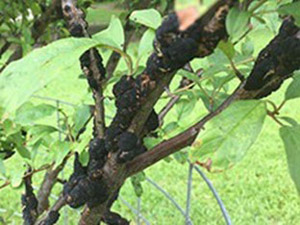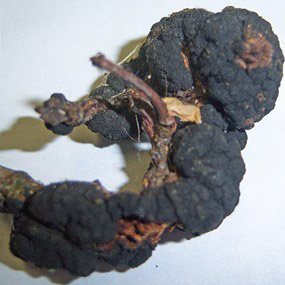Black Knot of Cherry and Plum
Contact
Plant Diagnostician
Phone: (479) 575-2727
Email: ssmith@uada.edu
Jason Pavel
Diagnostician
Phone: (479) 575-7257
Email: jpavel@uada.edu
Office:
University of Arkansas System Division of Agriculture
Cralley Warren Building
Room 16
2601 N. Young Ave.
Fayetteville, AR 72704
Black Knot of Cherry and Plum
by Sherrie Smith and Jason Pavel - March 2, 2023
Plant Health Clinic Disease Note: Issue 2

Black Knot of Prunus spp.- Apiosporina morbosa
Photo by Steve Kelley, formerly University of Arkansas Cooperative Extension Service
Before trees leaf out is the best time to see black, knobby galls on branches of cherries or plums. The common name of the disease is Black Knot, caused by Apiosporina morbosa (Dibotryon morbosum). This is a common fungal disease of Prunus spp.
Yield losses result from extensive dieback of girdled limbs and stunting of growth beyond the knots. Trees can be severely weakened, disfigured and, in extreme cases, killed because of infection.
What types of trees are affected by black knot?
Prunes, plums, sweet cherries, and sour cherries are all hosts for Black Knot. Rarely do we receive a peach sample with Black Knot. Wild cherries and plums serve as continuous sources of inoculum.
What are the symptoms of black knot?

Black Knot of Prunus spp.- Apiosporina morbosa
Photo by Logan County Extension office, University of Arkansas Cooperative Extension Service
The first symptoms are small, light brown swellings usually located at the base of the leaf petiole or on the fruit spur. These appear during the summer and first year after infection.
Young knots may have an olive-green color, but later become hard, brittle, and black in color. Older knots are coal-black in color and hard in texture. The knots often protrude more on one side of the affected branch.
How do I control black knot?
Control starts with pruning. Prune out and destroy all visible knots before new growth starts in the spring. The cuts should be made at least 6-8 inches below the lowest part of the knot. Cut out knots on large main branches and trunks with a knife or chisel, including an inch of healthy bark around the knot.
Never purchase plants showing knots or abnormal swellings on the twigs and branches. All clippings should be burned, buried, or otherwise removed from the property.
Mancozeb, Captan, Topsin M, or fungicides containing chlorothalonil are helpful in controlling Black Knot if the cultural controls are also practiced. Apply first spray in the spring just as green tissue begins to appear. Spray again just before and after bloom. Spray at 2- week intervals until new growth stops. Lime-sulfur sprayed during the dormant season is also helpful.
Wild cherries and plums within 600 feet of the orchard should be removed, when possible, to prevent spores blowing into the orchard and causing new infections. Some Plum cultivars are resistant to Black knot.
Take aways:
- Lime sulfur during dormancy
- Prune out all galls and
- Apply first spray in the
- Spray at 2- week intervals until new growth stops.
- Resistant cultivars are available
This work is supported by the Crop Protection and Pest Management Program [grant no. 2017-70006- 27279/project accession no. 1013890] from the USDA National Institute of Food and Agriculture.
Follow us on Facebook!